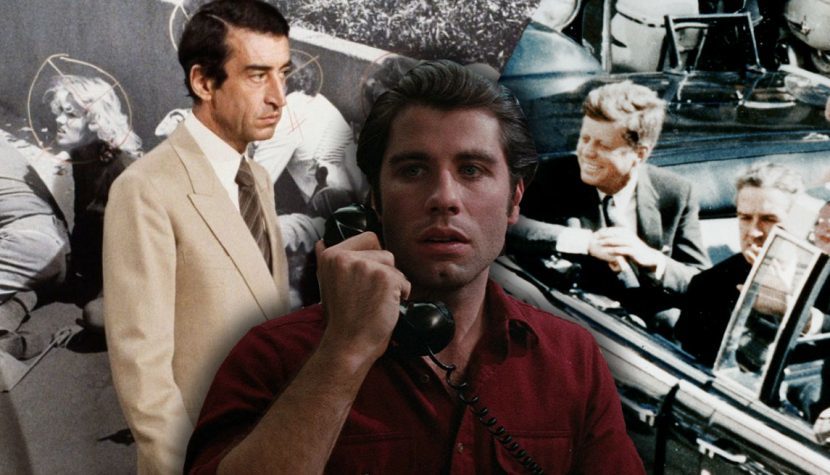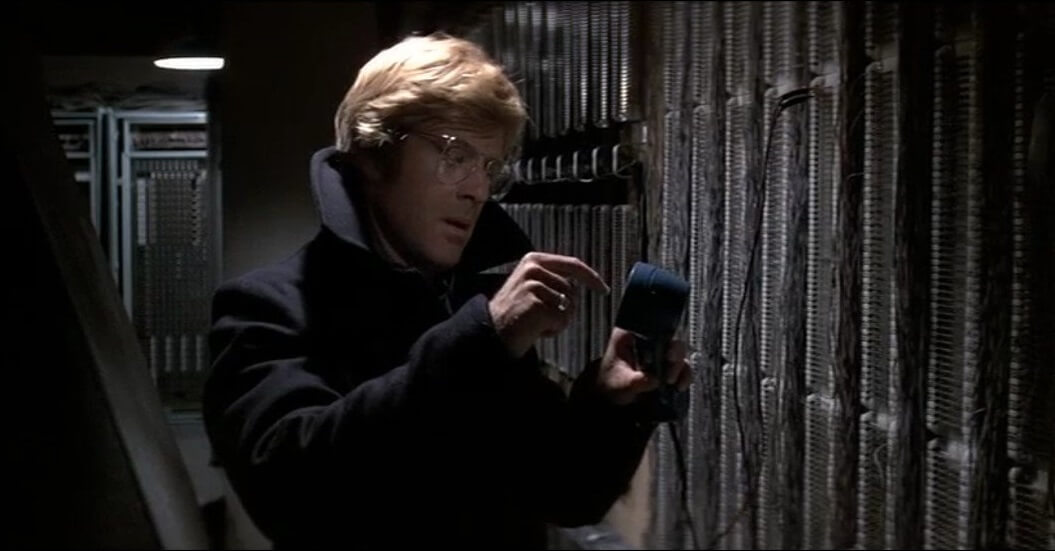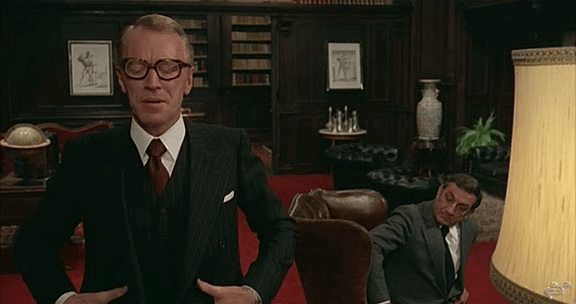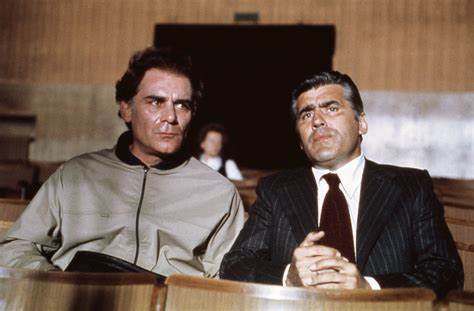CONSPIRACY THRILLER. Political movies, from which you will get PARANOIA

The world of politics symbolizes power, influence, privilege, but also the hostility of the gray citizen, to whom politics, and especially its highest levels, are associated with corruption, swindle and vacuousness. Representatives of the government have an impact on what life is like for the common man, so it is not difficult to believe that there is more behind their activities than what we hear in the media. In the history of the world, many improbable situations have happened, where not all the pieces fit together, so conspiracy hypotheses are formed to explain certain things. But conspiracy theories are also stories that go against what is considered to be the common truth. These are not always things related to politics, for example, there is a theory that William Shakespeare was just a figurehead, and the works he signed actually have multiple authors.
However, it’s a mistake to dismiss unconventional views as worthless, because there are, after all, conspiracies that have turned out to be true. They mainly concern the United States, that is, a country that has managed to become a world leader. The Americans, after the war, embarked on a space program, part of which was the employment of German scientists who were involved in war crimes during the Nazi reign of terror (Wernher von Braun, Hubertus Strughold and many others). This is one of the most famous conspiracy theories that have been confirmed. In cinema, the theme of political conspiracies was taken up most often in the 1970s, after the Watergate scandal (1972). That was also when the subject of the assassination of US President John F. Kennedy (1963) resurfaced. In the 1960s it was too fresh, commented on and analyzed mainly in documentaries. As a feature film theme, it was used more often after the decade.
This list includes 10 titles in chronological order. All are from the 12-year period (1969-1981), when the surrounding reality and climate were most conducive to the creation of paranoid stories.
1. Z (1969), dir. by Costa-Gavras

Costa-Gavras’ film, as well as the novel that formed the basis of the screenplay (by Vassilikos, published 1967) were inspired by the assassination of a prominent politician that occurred in 1963. However, it wasn’t President Kennedy, but Greek anti-war activist Grigoris Lambrakis. This event was a watershed moment in Greece and led to the military dictatorship that reigned from 1967-1974. Therefore, a film treating these events couldn’t be made in Homer’s country. France and Algeria are responsible for the production – interestingly, in the same year the French entered Éric Rohmer’s My Night at Maud’s (1969) in contention for an Oscar, so the producers of Gavras’ film staged their work to represent Algeria. It was a right shot – Z won the Academy Award for Best Foreign Language Film, as well as a host of other honors, including the Cannes acting award for Jean-Louis Trintignant and the British Academy Award for Best Original Score for Mikis Theodorakis.
A well-deserved Oscar went to editor Françoise Bonnot (she edited Roman Polanski’s The Tenant, among others), thanks to whom the film has a perfect rhythm, is dynamic, and watches like a passionate thriller, although the director probably wanted to make a political satire. This is indicated by several tragicomic scenes, such as the prologue, in which a lecture on mold turns into ideological gibberish. Or the motif of the stunned witness, where almost everyone – from the head of the gendarmerie to the witness’s mother and wife – knows better what happened to him. As if that wasn’t enough, a guy with a truncheon, who has messed up at the demonstration, enters the room and, seeing the journalist, runs off sprinting to the hospital bed, even though his leg is in a cast. There are times when it’s grotesque like Monty Python, yet overall the film is terrifying. The opening credits state that any similarities to authentic characters and events aren’t coincidental.
The intrigue centers around an opposition politician (Yves Montand) with pacifist views who falls victim to violence during a rally held with peaceful intentions. He is run into by a tricycle in what is made to look from afar like an accident caused by drunken hooligans, Vago (Marcel Bozzuffi) and Yago (Renato Salvatori). But the politician has been hit very solidly on the head and his life is in danger. Involved in the case are a young photojournalist (played by the film’s producer, Jacques Perrin) and an investigating judge (Jean-Louis Trintignant), on the surface a cold bureaucrat, in fact a noble fighter for the truth. Facts that are inconvenient for the authorities, especially the gendarmerie, come to light. Will there be indictments of high-ranking officers? Does the conspiracy reach even higher than the rank of general? One thing is indisputable – in this case we are dealing with a masterpiece of political cinema.
2. The Parallax View (1974), dir. by Alan J. Pakula

Mediocre journalist Joseph Frady (Warren Beatty) tries to force his way into a party to which he has no invitation. At a party held in Seattle’s futuristic Space Needle building, an assassination occurs, the victim of which is a U.S. senator, a widely respected man. One of the assassins is killed while fleeing, the other manages to slip away. A special committee – following the example of the Warren Commission investigating the Kennedy assassination – concludes that the assassination was the work of a single fanatic, and there is no reason to believe that anyone else was behind it. Over the next few years, people who were guests at this party die under mysterious circumstances. It seems that Joseph Frady was extremely lucky not to have attended the unlucky meeting. But his friend, TV reporter Lee Carter (Paula Prentiss), saw the murder and is convinced that she is in danger. She informs Frady of her concerns, who treats her like a hysteric, not taking her words too seriously.
Before Alan J. Pakula took on the Watergate scandal (All the President’s Men, 1976), he told the story of a fictional journalistic investigation taken from Loren Singer’s novel The Parallax View (1970). The opening credits include the name of only one actor, Warren Beatty, which is very significant for the reception of the film, because it suggests that each of the other characters may not live to see the finale. The actions of the main character cause concern, because Beatty does not give the impression of being an intelligent person – he has a lot of luck, but in his profession he is not very good. However, it happens in the journalistic environment, too, that when a reporter finds a great topic, he does not need special skills to be appreciated, the importance of the topic is enough. So when Joseph Frady finds himself on the trail of a corporation called Parallax he is faced with a chance to make headlines. At best, he’ll be a candidate for the Pulitzer Prize; at worst, he’ll be the one the newspapers write about in the obituary section.
When the protagonist decides to enter the ranks of the criminal syndicate for the sake of the investigation, he is brainwashed. The viewer also, because a series of repetitive photographs scroll across the screen for four and a half minutes. This is annoying, but crucial to the film’s content. Alan Pakula’s work contains bravura action scenes, such as a bar brawl and a police car escape. Attention is drawn to the interesting visual composition, which is kept in shades of gray, which is most likely due to cinematographer Gordon Willis, who had a large part in The Godfather Trilogy. The film is very well cast. Warren Beatty, despite the story of his love conquests, doesn’t look like a hunk from a fashion magazine, but an ordinary, gray and boring citizen easily found on the street. In the role of Joseph Frady he is convincing. In the background, especially at Paula Prentiss and Hume Cronyn, I didn’t notice any false notes either. A film about discovering the truth looks honest in its message.
3. Three Days of the Condor (1975), dir. by Sydney Pollack

A New York office is attacked, almost the entire team is killed. The victims are CIA employees, but not field agents. They are a group along the lines of a book society. They are engaged in reading and analyzing books to find leaks and codes, and send their reports to Washington. Most likely, one of the reports contained top-secret information that shouldn’t appear to the eyes of a rank-and-file employee. There must be a valid reason why an entire section was eliminated. But one employee managed to get out unscathed – his code name is Condor (Robert Redford). When he contacts CIA headquarters, he cannot be sure that he will receive protection from there. He is on his own and when he gets a young woman, Kathy (Faye Dunaway), involved in his problems, he puts her at risk of death in the process. From now on, even opening the door to the mailman can be a danger.
Robert Redford has appeared in seven films by Sydney Pollack, the fourth being an adaptation of James Grady’s novel Six Days of the Condor (published 1974). A tale of loneliness emerges from the gripping spy thriller. The main character is totally lost in a new situation. With no training, no plan of action, he is an unpredictable man, acting on impulse, desperate to find out why he has become a target. He meets a woman, but this relationship has no future. Kathy is a photographer, and the photos she takes say a lot about her introverted nature. And although she says she lives with a boyfriend and there are indeed men’s shirts in her closet, we never see this man, which is quite significant for the perception of Kathy’s character and her relationship with Condor. On the other hand, the assassin played by Max von Sydow, despite his seemingly different character, has a similar depth – in his profession, making friends is inadvisable, because one day he can have a nice conversation with someone, and the next day kill him.
The picture is perfectly in line with the paranoid cinema of the 1970s, when scandals surrounding people in power made the ordinary citizen lose trust in government institutions. When oil is more important to politicians and executives than human lives, something is wrong here. The system set up to protect ordinary citizens is itself becoming a threat to human beings. Film is a cold and rough, slowly revealing the cards, with a pessimistic tone (there is even a suggestion in the finale that the media and press are controlled). Between 1959-1973, the CIA conducted many illegal activities, which were described in a series of reports collectively called “Family Jewels”. Most of these were only publicly revealed in 2007, but some of them came to light in December 1974. However, the film had already been shot by then (though perhaps not yet edited), so the filmmakers could not have known about these CIA “dirty tricks.” Although Pollack and Redford considered themselves liberals and were involved in politics, their goal wasn’t to make a political film, but a gripping Hitchcock-style thriller. But the fact is that the picture remains relevant to this day, and its content – while horrifying in its telling – is not too far from the truth.
4. Illustrious Corpses (1976), dir. by Francesco Rosi

It wasn’t just America in the 1970s that was a troubled, politically and socially unstable country, where conspiracies could be seen at every turn. In Italy, too, chaos reigned, and out of this came a series of paranoid thrillers. Among writers, Leonardo Sciascia was among the masters of the genre, and in cinema his voice was spoken by such filmmakers as Elio Petri, Damiano Damiani and Francesco Rosi. The latter realized Illustrious Corpses, an intelligent and hard-hitting crime film starring Lino Ventura as an inspector investigating a series of murders of judges. “One murder of a judge is a police matter, four is already politics,” falls such a sentence in this film. The list of suspects is initially small, consisting mainly of those who have been acquitted after serving time provided for them by the high-profile judges.
The film won the two Italian equivalents of the Oscars, the David di Donatello Award, in the major categories of Best Picture and Best Director. Playing violent gangsters as well as noble law enforcement officers with equal skill, Lino Ventura as police detective Amerigo Rogas is thrown into an atmosphere of political tension. There are demonstrations where the judicial caste is called the Mafia. As usual, the main character does his job – gathering information, sorting out facts and securing evidence. But as is common in conspiracy thrillers, all this may not be enough, because the political mafia has stretched its networks so far that one lone righteous (or two – Rogas has an ally, a communist journalist played by Luigi Pistilli) is unable to threaten them. Even the dog is part of the conspiracy – when Rogas talks to a trusted journalist, a dog with a wiretap in its collar is sent to spying.
Cinematographer Pasqualino De Santis (Oscar for Franco Zeffirelli’s Romeo and Juliet) has created a very bleak picture of the metropolitan jungle. The very first scene takes place in the crypt, where the more than 80-year-old Charles Vanel (The Wages of Fear, 1953), looking almost like a living corpse, watches human mummies and then joins the ranks of the respectable dead. The first scene usually establishes the mood of the film, and here we have a prologue set partly in the catacombs, preparing the viewer for a cinema as unpleasant as the stench of decay and death. Moreover, this mood the director managed to maintain with iron consistency until the last minute. The cast includes great actors Fernando Rey and Max von Sydow, but Lino Ventura is also excellent in his role – at first he plays the role of an observer, characterized by emotional coolness, but when he begins to realize what swamp he has gotten himself into, his aloofness turns into sweat, fear and paranoia.
5. I Am Afraid (1977), dir. by Damiano Damiani

Police brigadier Ludovico Graziano (Gian Maria Volontè) is assigned to protect Judge Cancedda (Erland Josephson), but the latter doesn’t support such a turn of events. He says that protecting the judge shows the decline of civil society. He is an idealist, a man of integrity, but also a naive man who believes that by being just, one can gain respect. The bodyguard, due to the nature of his profession, is more cautious, aware of the danger. He is the one who utters the title words, specifically saying: “I’m afraid of what I don’t understand”. In his mind are the victims of the mysterious murder committed in the prologue of the film. The victims were a judge and his bodyguard, so it is likely that now they, Graziano and Cancedda, may find themselves targeted. As they stumble onto the trail of an affair involving the secret service, the noose around their necks tightens more and more. Soon the mysterious Judge Moser (Mario Adorf), the complete opposite of the noble Cancedda, appears in the path of the police brigadier….
I can’t get out of admiration how good this film is. From beginning to end thought out to the smallest detail. There are sparks between the characters, which means that no fireworks are needed to create a thrill. One should watch carefully, as the intrigue is quite intricate, with more and more new characters appearing on the screen, who may or may not play an important role, as their purpose may also be to distract the viewer, to weaken his alertness. The story is fictional, although certainly some characters have their counterparts in reality. The production is credible, inspired by front-page newspaper articles and respecting the principles of realism, seasoned with witty dialogue and accurate social observation. Fear is normal, only crazy people aren’t afraid. Wearing a bulletproof vest doesn’t indicate cowardice. Graziano is afraid because he doesn’t know who to trust. Even the noble judge is a threat to him, because he tries to uncover too many secrets and exposes himself to influential people.
In addition to good dialogue, the film features well-paced action with a gripping climax in the movie theater. Gian Maria Volontè scores another great performance, but he also has an experienced partner in the person of Swedish actor Erland Josephson, known for Ingmar Bergman’s films, among others. When Mario Adorf appears on screen, the tension level glides even higher. Not bad, although very sparing, is the music by Riz Ortolani. For me, this is excellent cinema and one of the more interesting representatives of the Italian political thriller. The picture shows the security services in a cynical way, but nevertheless puts crystal heroes in the center. Such heroes still exist, but they are doomed because the world is completely broken by corruption, violence and political games.
6. Capricorn One (1977), dir. by Peter Hyams

Lunar exploration has also become the subject of the conspiracy theories. The series of space flights of 1969-1972, according to some, was a series of cleverly prepared mystifications by NASA. There was even a hypothesis that Stanley Kubrick, the creator of the outstanding science fiction production 2001: A Space Odyssey (1968), was involved in the deception. The scenes with people walking on the moon were allegedly directed in a specially prepared TV studio. It’s possible that such thinking was heavily influenced by the thriller Capricorn One, from which stills and scenes were used more than once in material on space mystifications. The film’s director, Peter Hyams, reflected on the power and importance of television broadcasting. With such a powerful medium, in which editing and special effects play a large role, it is easy to fool someone. The plot, however, is not about a trip to the moon, but to Mars. And despite the negative portrayal of the government agency, the filmmakers have received technical support from NASA.
Three astronauts are to be sent to explore the Red Planet. Their expedition is to be televised. However, it turns out that they are to be only actors, while the Martian setting was built in a closed studio, far from civilization, in some hangar in California’s Mojave Desert. Up to a point, everything goes according to plan, no one suspects anything, not even the families. But “on the way back”, during entry into the Earth’s atmosphere, a malfunction occurs and the astronauts are officially declared dead. It becomes clear to the “cosmonauts” that the space project is too expensive to allow mistakes. The mystification must therefore not come to light and the astronauts must die for real. They begin a race with their lives at stake. They have an unexpected ally, an insightful reporter who began investigating the case after his friend went missing and someone tried to kill him.
Capricorn One is largely an exciting adventure cinema, providing thrills, making the viewer sympathize with the characters, wanting the lies to be exposed. Charles Brubaker’s (James Brolin) adventure in the desert is a survival classic – hunger, fatigue, snakes and scorpions. It’s also a fight against time – if he doesn’t reach civilization quickly to prove the government’s scam by his very presence, the desert will kill him. The thread of journalist Robert Caulfield (Elliott Gould) conducting a private investigation is capably played out, containing a bravura scene of driving a car without brakes, cleverly shot – with the camera inside the car and “on the bumper”, a wide set was used only at the end of the scene. Moreover, good suspense was achieved in the seemingly ordinary scene of the astronauts’ conversations with their wives during the live TV broadcast. Of the cast, in addition to Elliott Gould and James Brolin, Telly Savalas stood out in an episodic role, but one of great importance to the resolution of the intrigue.

